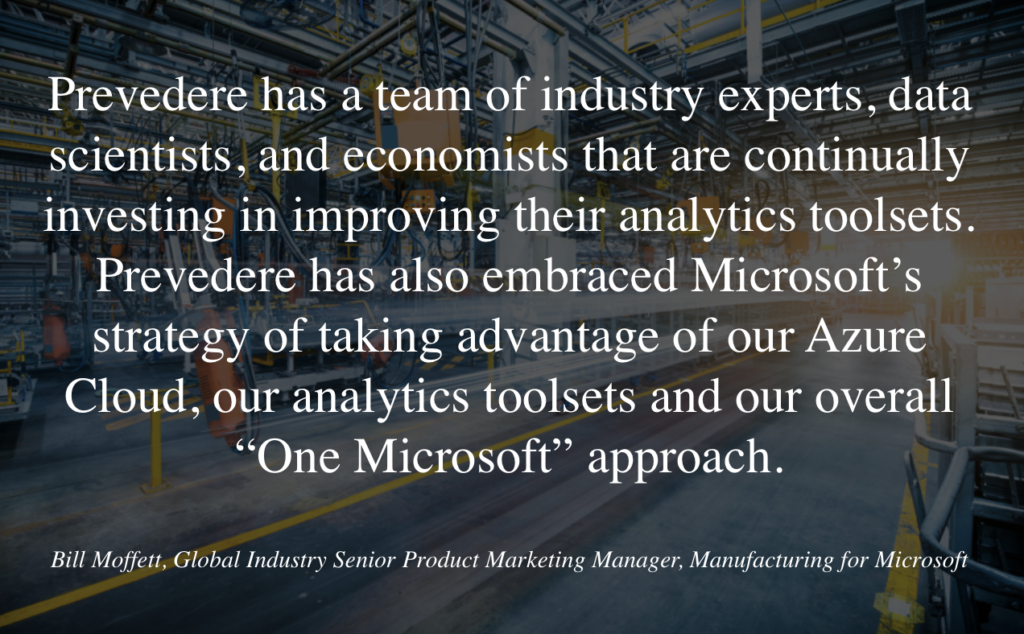Last Updated: June 22, 2018
 Bill Moffett, Global Industry Senior Product Marketing Manager, Manufacturing for Microsoft, and Pawan Murthy, Senior Director of Marketing at Prevedere, discuss the historical challenges of forecasting demand for manufacturers and how Microsoft uses predictive analytics to help them be more competitive.
Bill Moffett, Global Industry Senior Product Marketing Manager, Manufacturing for Microsoft, and Pawan Murthy, Senior Director of Marketing at Prevedere, discuss the historical challenges of forecasting demand for manufacturers and how Microsoft uses predictive analytics to help them be more competitive.
Q&A Discussion: How Microsoft Uses Predictive Analytics to Help Manufacturing Clients
Murthy: When it comes to accurate forecasting, what are the key challenges manufacturers face?
Moffett: Forecasting demand has always proven difficult for manufacturing business leaders – so much so that it is considered business as usual to not analyze, predict and anticipate every phenomenon that affects the business because it would be an exercise in futility. Trusting the data has been a challenge, and manufacturers have spent more time debating the numbers and their accuracy than trying to learn from them to make business decisions.
The digitization of industries has only increased the challenges involved. Faster requirement needs, an increase in the number of players and sourcing channels, more transportation modes and larger geographical areas create an incredibly complex web of variables to consider when forecasting demand. Plus, additional variables have to be analyzed for accurate forecasting to occur … external factors that manufacturers have traditionally never been able to include in their analyses. These can throw a wrench in even the best-laid plans after strategic decisions have already been made.
These challenges are further highlighted by the fact that forecasting has typically relied solely on historical performance. With access to limited information, anecdotal feedback, speculation, and educated guessing by planners all have a greater influence than they should. Forecast accuracy often depends on hope and a prayer when it does not include accurate marketplace data.
Murthy: What advancements in technology and analytics are manufacturers leveraging to overcome those challenges?
Moffett: Digital transformation is changing the game for manufacturers. Traditional forecasting techniques were based on leveraging historical information from internal sources that manufacturers could control. The opinion was that including additional external market variables in the decision-making process was simply not manageable. Once manufacturers understand that they can now get accurate information from the marketplace and external data sources and tread outside of the traditional historical planning approach they have always done, their eyes open.
Microsoft uses predictive analytics tools like Prevedere that allow manufacturers to digest so much more information and see trends that simply were not possible before. Consider unforeseen global factors and environmental impacts such as an unexpected hurricane or snowfall that may affect inventory delivery. Or social media activities that can spike prices or negatively influence a long-term marketing campaign that now needs to adjust due to macroeconomic trends.
Big computing power through the cloud is a game changer as well. It is one thing to be able to get all this data from key points of information, but if you cannot effectively analyze the data and then take that and turn it into usable information then you really are not that much better off.
The Benefits: Microsoft Uses Predictive Analytics to Improve Client Performance
Murthy: What are the benefits of adopting predictive analytics to improve forecasting?
Moffett: There are four key benefits that predictive analytics deliver to business leaders:
- Validating current strategy. Often, a company’s strategic direction is questioned without concrete evidence that it is the right path. Predictive analytics provides the validation needed for expansion plans or market viability. Leveraging these insights guides future forecasting discussions among sales and acts as a sanity check for budget estimates with finance. Finally, these insights give business leaders the vision and foresight to capitalize on changes within the industry before their competitors do.
- Discovering hidden performance drivers. Since traditional demand forecasting is often based on historical and/or internal data, institutional beliefs among industry leaders become a guiding post for managing demand. Data-driven insights address these beliefs for better or for worse, but also allow for adjusting based on factual data. Future economic risks can be identified, allowing enough lead time to adjust and make meaningful changes in production or resource allocation.
- A 360º-view of future demand. Rather than reacting to demand as it occurs, companies instead act upon the actual drivers of demand and adjust marketing, sales and resource allocation based on the latest demand sentiment. With this understanding of demand drivers for their businesses, sales predictions will be more accurate.
- Optimizing ROI on operational spend. These actionable insights maximize the ROI spent on operations. The ability to identify the time and region in which to make capital investments are more easily understood, allowing for intelligent resource allocation. Marketing campaigns and pricing efficacy is clear, revealing changes that need to be made for maximized success.
Murthy: How are you seeing the manufacturing industry adopt predictive analytics?
Moffett: Manufacturers are clamoring for any additional business insights. They have traditionally worked on very small operating margins, and any amount of improvement provides significant upside to overall profits – especially as it relates to inventory and the costs associated with production.
The challenge now is to take how Microsoft uses predictive analytics and move it from a technical discussion into a business discussion. This really is a digital transformation discussion, and business leaders are now in a place to want to have that talk. Manufacturers that are able to plan most accurately using analytics tools are better equipped to prioritize asset usage and resource management more effectively, and therefore have a leg up on their competition.

Murthy: How does Prevedere Demand Planning benefit Microsoft’s manufacturing customers?
Moffett: Prevedere has a level of focus and commitment to understanding predictive analytics and the impact it can have on effective demand forecasting, which is exactly what our customers are seeking. They have a team of industry experts, data scientists, and economists that are continually investing in improving their analytics toolsets. Prevedere has also embraced Microsoft’s strategy of taking advantage of our Azure Cloud, our analytics toolsets and our overall “One Microsoft” approach. Prevedere’s demand forecasting capabilities are something that many of our customers cannot develop on their own, but can now access with the Demand Forecasting solution.
To learn more about Prevedere Demand Forecasting for Manufacturing visit Microsoft AppSource.